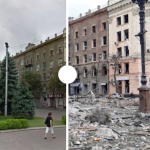US users were responsible for most posts on X mentioning the location of a recent violent protest in Ireland in recent days, data obtained by Sky News shows.
On 25 April, a group of anti-migrant activists assembled in Ireland to protest outside a site being converted to asylum accommodation near the town of Newtownmountkennedy.
Within hours, the scene became violent. Video recorded in the evening showed a fire was lit at the site, and activists clashed with officers.
Migration to Ireland has become a focus of debate beyond the country’s borders. Prominent figures from the United States and elsewhere have frequently weighed in on social media, pushing it further into the international spotlight.
An analysis of social media data by Sky News has revealed the role played by international users in stoking the division.
Posts mentioning Newtownmountkennedy
Sky News examined posts on X authored between 2 April and 1 May using the social media monitoring tool Talkwalker.
Ex-politician seen beating his wife to death in CCTV footage – sparking outrage in Kazakhstan
Ukraine-Russia war latest: ‘Huge fire breaks out’ in port city after missile strike; Russia ‘shifting battlefield focus’
Georgia protests: Stun grenades used on demonstrators as ‘Russia bill’ moves to next stage
A search of X posts mentioning Newtownmountkennedy shows only 75 were posted on 24 April. But on the day of the protest, 25 April, this spiked to 26,801 posts.
As social media users discussed the violent confrontations the following day, the number of posts mentioning the town peaked at 53,907.
The Talkwalker data shows of the posts mentioning Newtownmountkennedy, 56.1% were from users in the United States.
Posts from users based in Ireland were the second most common, accounting for 20.9% of the total. While 9.6% of posts came from users based in the United Kingdom.
Of the five accounts that attracted the most engagement on posts including the term Newtownmountkennedy, three were based outside of Ireland.
The most engaged with account was an Irish activist posting footage of the event, the second was The Liberal, an online publication in the country.
Tommy Robinson, an English far-right activist, attracted the fourth most engagement. In total, his posts mentioning the town were engaged with 42,500 times.
Use of the hashtag #IrelandBelongsToTheIrish
To better understand the conversations surrounding this topic, Sky News looked at two hashtags commonly used in relation to anti-migration protests in Ireland.
Use of the hashtag #IrelandBelongsToTheIrish began to spike on 25 April, the day of the protest. Use of this term continued to increase over the following days, peaking at 11,420 posts on 28 April.
As with mentions of Newtownmountkennedy, users outside of Ireland authored the most posts on X mentioning this hashtag, according to the data obtained by Sky News. 57% were posted by accounts based in the United States, 24.7% by Irish users. A further 8.8% were attributed to users based in the United Kingdom.
While four of the top five accounts attracting the most engagement on posts mentioning this hashtag were based in Ireland, the fifth belongs to Alex Jones, an American media personality and conspiracy theorist. Jones’s posts using this hashtag were engaged with 10,700 times.
Use of the hashtag #IrelandIsFull
The hashtag #IrelandIsfull followed a similar trend. Mentions of the term peaked on 26 April, being used in 10,498 posts on that day.
Once again, American accounts authored most of the posts mentioning #IrelandIsFull in the time leading up to and following the protest.
In total 54.4% were posted by users in the United States. 28% came from Irish accounts, and 8.1% were posted by accounts from the United Kingdom.
Of the five accounts that attracted the most engagement using this hashtag, all were Irish.
The Data and Forensics team is a multi-skilled unit dedicated to providing transparent journalism from Sky News. We gather, analyse and visualise data to tell data-driven stories. We combine traditional reporting skills with advanced analysis of satellite images, social media and other open source information. Through multimedia storytelling we aim to better explain the world while also showing how our journalism is done.






















